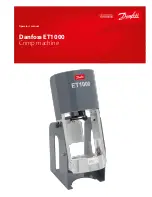
42
Veritas
®
Mk.II Power Sharpening System
– usually only for face- or edge-grain cutting with a standard
block plane; a cap iron is not needed when cutting end grain.
Because these planes have only a narrow bed lip and a frog
post for the blade to rest on, it is desirable that the lever cap
extend at least to a point above the bed lip; otherwise, it will
be pressing on an unsupported section of the blade.
The lever caps on both of the Stanley block planes are about
1
/
4
in. short of what they should be, and the lever cap on the
Record #060
1
/
2
is nearly
1
/
2
in. short. To compensate for
this, you should lower the bed angle by 1° or 2° to ensure
that the pressure of the short lever cap does not cause the
blade to arch away from the front of the bed. Assuming
that you have done that and all the other necessary tune-up
procedures, you can turn your attention to the blade.
Bevel Angles
The standard block plane (#9
1
/
2
) has a bed angle of 20°.
Since the blade is used bevel up, if we put a standard 25°
bevel on the blade, we will end up with a cutting angle of
45°. This just happens to be the same cutting angle that
we have for a smoothing plane, which has a bed angle of
45° but where the blade is used bevel down. So when you
sharpen the blade of your standard block plane at 25°, you
produce what is in essence a smaller smoothing plane.
But there is nothing to say that you can’t put two bevels
on a plane blade. You can easily grind and hone a 15°
bevel on the blade and then put a 10° back bevel on the
face of the blade (as shown in the top drawing at right).
This would still leave you with a 25° included angle,
but you would now have reduced your cutting angle
from 45° to 35°. You are still left with a 10° relief angle,
which is perfectly adequate for block-plane use.
Possibly more signifi cant, you have sharpened the blade
of your standard block plane in a manner that will give
you a lower cutting angle than someone who sharpens
a low-angle block plane in a standard fashion (12° bed
angle plus 25° bevel, a total of 37°).
All of this dazzling footwork with bevel angles
now raises the question, “Why do we bother with
a low-angle block plane?” It is a good question.
The answer is that lower bed angles not only let
you use lower cutting angles but they also align the
blade more closely with the direction of cut, thereby
minimizing chatter. The lower you make the bed
angle, the closer you approach the function of a
chisel, which does not chatter.
Bevel Angles for Low-Angle Block Plane
Bevel Angles for Standard Block Plane
Grinding a Crown on a Blade
There are many ways to grind a
crown on a blade. The jig shown
here works with a dry grinder or
belt sander. Using thin wood as a
table extender, drill holes in it as
required and use another piece of
wood as a rotating arm. With the
plane blade attached to the rotating
arm with double-faced tape, you
can select the amount of crown
you want on a blade by picking a
suitable point of rotation. About 7-
in. radius is fine for a #4
1
/
2
or #5
1
/
2
plane blade. For fine adjustment,
you can make the rotating arm
adjustable in length.
35° cutting
angle
15° bevel
10° back bevel
10° relief angle
27°
20°
32°
7°
5°
15°
25°
20°
Softwood configuration
General purpose
7°
5°
Grinding wheel
(or belt sander)
30°
Front View
Side View
Rotating arm
Plane blade
Tool-rest table
Crowned blade
Fix blade on arm with
double-faced tape.
Table extender
Содержание Mk.II
Страница 6: ...vi Veritas Mk II Power Sharpening System ...
Страница 14: ...8 Veritas Mk II Power Sharpening System ...
Страница 20: ...14 Veritas Mk II Power Sharpening System ...
Страница 33: ...27 Exploded Assemblies Master Parts List 5 3 13 9 7 2 14 24 21 1 6 22 20 19 18 17 16 15 23 4 ...
Страница 36: ...30 Veritas Mk II Power Sharpening System ...
Страница 70: ...64 Veritas Mk II Power Sharpening System ...
















































